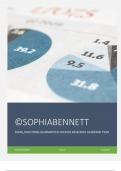Exam (elaborations)
THE PRINCIPLES OF LEARNING AND BEHAVIOR 7TH EDITION MICHAEL DOMJAN - TEST BANK
- Course
- Institution
1. Pavlov’s study of classical conditioning began as an extension of his work on a. digestion. b. pain. c. the auditory system. d. the knee-jerk reflex. ANSWER: a REFERENCES: Page 58 KEYWORDS: Fact 2. Pavlov supplemented the funds for his laboratory by which of the following? a. tra...
[Show more]




